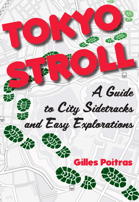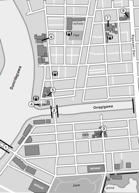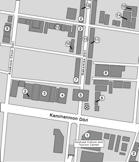











Tokyo Stroll Supplement: Eating In Tokyo

This page is to assist you in finding food as you explore Tokyo. While the page is part of the web supplement to Tokyo Stroll it is written to be of use to any traveler, not just those who bought my book.
I point to many sites on the internet that do a good job with the topic they cover. If any links are broken let me know so I can fix them.
You may also want to save some of the following information to your smartphone, or tablet, for quick reference when you are in Japan. It is possible to save web pages as PDF files and load them into your preferred e-book reading app. How this is done varies with your operating system and web browser.
Go ahead explore and push the boundaries of what is familiar in dining. If you are like me you will find yourself both eating more than you would at home and losing weight from all the walking while exploring Tokyo. In any case enjoy exploring the foods available at Japanese restaurants and coffee shops. Here is a suggestion. Don't eat the same dish twice on your trip. You can have rāmen or donburi more than once but not the specific dish.
| BASICS | RESTAURANTS | SPECIAL DIETARY NEEDS |
|
- - Japanese and Chinese Restaurants - - Restaurant chains focusing on noodle dishes - - Sushi - - Western style restaurant chains and foreign chains in Japan |
BASICS:
It is handy to know the name of what you want, including specific varieties, for example with soba, tempura, or rāmen. Be aware that even if you are familiar with the Japanese food available in your country you will quickly see many dishes on menus in Tokyo you have not heard of. Japanese food is far more varied and unfamiliar than many assume.
Tokyo Guide: How To Read Japanese Food Labels
Books:
I highly recommend buying and reading the following books before your trip to help identify most of what you are very likely to be eating. Both are available as e-books for easy reference when you are on the go:
Hosking, Richard
A Dictionary of Japanese Food: Ingredients & Culture
Ono Tadashi and Harris Salat
Japanese Soul Cooking: Ramen, Tonkatsu, Tempura, and More from the Streets and Kitchens of Tokyo and Beyond
Japanese neighborhood coffee shops are worth a stop. There you will not only find good coffee but a variety of simple dishes to enjoy. Foods often include yōshoku, a Japanese take on Western food you often don't find in restaurants these days.
Yoshoku Origins Revealed: 6 Supposedly Western Foods Invented in Japan
The Japanese take the word convenience seriously in running their convenience stores. You will find many everyday items you need at local ones. For food they have a large selection of bentōs, onigiri, sandwiches, hot food at the register, even seasonal foods that change as the year goes on. Then consider pastries, deserts, candys, and a large variety of beverages. Be aware on the beverage side that whisky and coctails are available in cans so don't get them assuming they are beer.
Japan also has good street food, food trucks are becoming more common and often show up at lunch time in business districts. At night a type of moveable stall called a yatai can be found near some train stations serving hot food. I have even bought yakitori sold from a sidewalk stands. Festivals of course will have a variety of foods, there is usually a place to sit and eat nearby as eating while walking is considered gauche, or even rude.
Always assume the staff will not know English and take the time you need to choose your meal. Mom and pop restaurants will be laid back and helpful. I have found that at mid-level restaurants the staff can be nervous about language barriers as they are trained to be very polite.
Chain restaurants usually have English language menus, often they also have menus in other languages such as Korean and Chinese. Japanese only menus often have pictures of the item being served which helps making a decision.
Some restaurants have ticket machines at the entrance where you choose your order. Older ticket machines have a picture of the main entre and the price. Newer machines are touch screen and often have an English text option. This eases communication, you select what you want, buy your ticket, find a seat, and hand the waitstaff your ticket.
Set meals are common in many restaurants. These often include miso soup, rice, a main dish and a small side dish.
Most restaurants are not open for breakfast, however finding food is not hard. Chains are often good for breakfast. Check what is available near your accommodations when you arrive. My favorite is Yayoiken for a traditional Japanese breakfast.
Think beyond the chain restaurants you have at home, many of which do have Japanese branches so I will include them in the links. Japanese chains have good food, good prices, and the advantage of a certain familiarity if you are too tired to easily make decisions as to where to eat. A common food served at many of these is donburi, food served over rice, curry rice is also popular. I do encourage you to eat at small family run places which are also excellent and worth supporting.
Menus in some are seasonal with items cycling on and off the menu through the year.
NOTES:
Some of these restaurants have branches overseas. However do not expect the menus in Japan to be the same.
Chain restaurants are almost always non-smoking, or limit smoking to a separate room.
Japanese and Chinese Restaurants:
Bamiyan - A variety of Chinese and Chinese inspired dishes.
CoCo ICHIBANYA - Specializing in curry rice, they also have a vegetarian curry with no meat in the sauce.
Gindaco - specializing in takoyaki, grilled balls of dough with bits of octopus in them.
Gyu-Kaku - Japanese grilled BBQ, you cook at your table.
Karayama - The menu is mainly based around chicken.
Kushikatsu Tanaka - Meat, seafood, and vegetables coated in panko, skewered then deep fried.
Matsuya - Set meals, donburi, curry rice and more.
Nakau - Donburi, udon, curry, and set meals.
Ootoya - A variety of set meals.
Sukiya - Donburi, especially gyudon, and set meals.
Tendon Tenya - Tendon is tempura over rice, they also have a variety of other dishes.
Tsubame Grill - Famous for the hamburger steak, they also make sausages and croquettes.
Yakiniku Like - Japanese grilled BBQ, you cook at your table.
Yayoiken - Great for traditional Japanese breakfasts and a variety of other items.
Yoshinoya - Gyudon, beef over rice is what they are best known for, they also have chicken and pork dishes.
Restaurant chains focusing on noodle dishes:
Fuji Soba - The menu centered on hot or cold soba and hot udon dishes. They also have donburi and curry dishes. Fuji Soba is one of the places that uses ticket machines at the door.
Hanamaru Udon - Mainly udon with donburi and tempura as options.
Marugame Seimen - Udon dishes, they also serve donburi, tempura, and onigiri.
Oreryu Shio Ramen - As the name states they focus on shio-rāmen, "salt rāmen". They also have miso rāmen, set meals, and the side dishes one commonly finds at rāmen restaurants.
Spajiro - Spaghetti made with a strong Japanese style, this is wafū, or Japanese-style Western food.
Many sushi chains are kaiten-zushi, conveyor belt sushi, restaurants. The bill depends on the number of plates left after you finish eating. In most kaiten-zushi restaurants the dishes are different colors indicating different prices.
Kura-sushi - Kaiten-zushi.
Sushiro - Kaiten-zushi.
Sushizanmai - Pricier than kaiten-zushi places but the toppings are generous. They also have assortments, sashimi, grilled dishes, tempura, soups, and various sashimi donburi served with miso soup.
Western style restaurant chains and foreign chains in Japan:
You should expect good quality familiar dishes with a Japanese twist. Even if you find eating Western woods weird while visiting Japan some of these may tempt you with dishes that you cannot get at home. Three common types are coffee shops, hamburger joints, and diners which the Japanese call family restaurants.
Denny's - Family restaurant.
Doutor Coffee - Coffee shop serving sandwiches, burgers and hot dogs.
Freshness Burger - Hamburgers, hot dogs, fries.
Gusto - Family restaurant.
HUB - A chain of British style pubs, non-smoking.
Jonathan's - Family restaurant.
KFC - Similar to what KFC sells in the US.
Lotteria - Hamburgers, fries.
Lucky Rocky Chicken - A variety of chicken dishes including burger style chicken sandwiches
McDonalds - Hamburgers, hot dogs, fries. Very similar to the menu you find in the US, but a little different.
MOS BURGER - A classic Japanese hamburger chain that incorporates a Japanese flavor to their food.
Royal Host - Family restaurant.
Saizeriya - Italian influenced food for a very good price.
Shakey's - Pizza, but very different than you get at home, very Japanese.
Sizzler - Meat as you would expect, a good salad selection, and cute kids’ meals.
Tully's Coffee - Coffee shop with simple food.
Vie de France - Bakery/restaurant. Self-serve with a variety of baked goods including some with meat or cheese.
Wendy's First Kitchen - Hamburgers. One interesting item is the ワイルド☆ロック "Wild Rock" where the "bun" is two beef patties.
1. Allergies and other food sensitivities:
Know your food allergies.
Be aware that a cooking stock, dashi, will likely be fish and kelp based. Dashi in a few cases may also be shellfish, meat, or plant based. Noodles almost always contain wheat with the exception of a few soba restaurants that do not mix wheat flour with their buckwheat flour. Fish paste products often include egg as a binder.
Cards:
Japanese Gluten Free Restaurant Card PDF
Equal Eats also has a variety of specialized cards, both plastic and download for printing/putting on your smartphone, which you can buy for your trip. Just be sure to select the card in Japanese.
General information links:
Food Allergies and Dietary Restrictions in Japan - Includes information on Halal foods
Traveling to Japan with Dietary Requirements
Common Food Allergens in Japan and How to Spot Them
Traveling to Japan With Food Allergies, a downloadable PDF.
Living in Japan with Food Allergies Part 1: Before You Go
Living in Japan with Food Allergies Part 2- Out and About
Living in Japan with Food Allergies Part 3- In Case of an Allergic Reaction
Given the increasing number of Muslim tourists from places like Indonesia the number of restaurants with halal food is growing. Muslim travels should not be surprised that many restaurants, including ones with halal food, in Japan serve alcohol, a long established tradition in Japan. You should also be aware that halal and non halal dishes are very likely prepared in the same kitchen. While it is possible to be certified as halal some restaurants serve halal food without certification as certification is often expensive for small family run businesses and needs to be regularly renewed, often annually. Some restaurants are what they call "Muslin friendly" and can explain what they do to provide a halal service without certification. Recently an organization called Japan Muslim Access in Saitama, just north of Tokyo, has been providing halal certification at no cost with a goal of making Japan more comfortable for Muslims. One hopes this helps increase the number of certified restaurants in the Tokyo Area.
NOTE: One option is to look at the vegetarian and vegan section of this page for possible foods that are acceptable.
Links to useful information:
Basics for Muslim Travelers in Japan
Halal Certification and the Concept of Muslim-Friendly in Japan
Ultimate Guide to Halal Japanese Food - BFF Tokyo
Your Complete Guide To Halal Authentic Japanese Food In Tokyo
The top 10 halal restaurants in Tokyo
Top 10 Muslim-friendly Halal restaurants in Tokyo
When it comes to kosher food it gets complex as there is a spectrum of what is acceptable depending on particular Jewish traditions and how observant an individual is. What works for those in the reformed tradition will not work for the orthodox, and there is diversity between those two extremes. I would not expect to find even a handful of strict kosher kitchens from an Orthodox Jewish perspective in all of Tokyo. However if that is not your concern Japanese food itself is usually easy to identify which helps greatly.
As for ingredients there are Japanese foods that are certified kosher and the list is growing as certification bodies continue their work.
One option is to look at the vegetarian and vegan section of this page for possible foods that are acceptable depending on how strict you are.
As seafood is such a major part of Japanese cuisine the Fish List provided by Chabad Lubavitch of Japan is a handy resource.
My first bit of advice is to get familiar with actual Japanese food. Most travelers know certain types of food, sushi, rāmen, etc. Japanese cuisine is varied so if you know what a dish is you can watch your carb intakes. Set meals at restaurants often come with rice, you can simply not eat it. Meat, seafood, and vegetables are common in Japanese cuisine so you have many options.
The two books I recommend near the top of this page will be useful for learning about what you see in restaurants. Most Japanese foods are easy to identify once you have some basic knowledge. You should expect plenty of ingredients you have not tried before, be brave and find delicious foods you will miss when you return home.
Consider getting the:
Japanese Diabetic Diet Card or the Diabetic Diet Printable Card (Instant Download), be sure to select Japanese.
Links to useful articles:
Diabetes in Japan | El Big Monday
Japanese food and beverages for diabetics and low-carb eaters
Tips for traveling to Japan with diabetes
Traveling in Japan with Diabetes
The first thing to consider is are you vegetarian or are you vegan? If you are vegetarian eggs and dairy are OK so you have more dining options? If you're vegan you will have to be more careful in selecting your food.
Before the end of the Tokugawa Shōgunate in 1868 most Japanese would not eat land based mammals. This was due to the influence of Buddhist prohibitions on meat eating. For the general population birds and fish were OK and part of the diet. This is why Japanese sometimes confuse vegetarianism with not eating mammals. Today Japanese food commonly includes meat and seafood so you have to be observant when deciding what to order.
While there are vegetarian and vegan options to most Japanese dishes certain ones usually are not. For example traditional Japanese recipes with simmered vegetables commonly involve cooking in a fish or meat based stock. It is safe to assume the same type of stock is in almost all soup dishes. Miso soup is almost always based on a stock made with fish, with rāmen the stock is usually chicken or pork based, Japanese curry roux often has butter or animal fat, tempura batter usually has egg.
This is why you should study up on the ingredients used in many dishes. There are vegan versions of all these examples and more, you just have to hunt them down.
Information Links:
These links, in alphabetical order, will provide some information on vegetarian / vegan food in Japan. If you know of others that would be helpful in restaurant eating let me know so I can add them.
A Guide To All Things Vegetarian In Japan
Best Vegetarian Chain Restaurants in Japan
Find Vegan Options in TokyoHow to Eat at a Japanese Restaurant the Vegan Way
Japanese Vegetarian Food Guide: How to Savor Japan's Cuisine
Restaurants in Tokyo with Vegetarian Options
The Ultimate Vegan (and Vegetarian) Survival Guide for Japan.
Vegan and Vegetarian Japanese Food: A Helpful Guide
Vegan Japan ヴィーガン日本 Facebook group
A Vegetarian and Vegan Guide to Japan
Vegetarian or vegan? Here’s how to eat your way around Japan
Vegetarian Survival Guide to Japan
Back to the Tokyo Stroll Supplement home page - Privacy Notice - Back to Gilles' home page
Created September 19, 2022 | Content last updated August 12, 2024